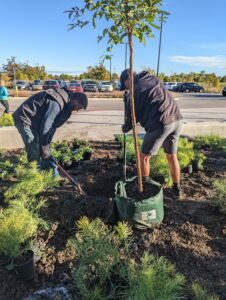When I was a kid, if you’d asked me what my favorite season was it would always immediately be summer. No school, time for playing outdoors, swimming, hiking, and late nights playing flashlight tag. Now, if I ranked the seasons from worst to best, they’d be Summer in last, followed by Winter (yes, I choose winter over summer), and a tie between Spring and Fall. With the best temperatures, a mix of sun and rain/snow, and an explosion of colors from new blooms in the spring to the reds, yellows, and oranges of leaves before they drop in the fall, Spring and Fall are by far my favorite times of the year. Well, we are nearly to the autumnal equinox with temperatures beginning to drop and the onset of some fall showers as I write this article. With Fall on the doorstep, I’ve received a repeated question recently, “Is it ok to plant a tree in the Fall?”
- Figure 1. Fall tree planting
The short answer to this question is, “Yes!” If you want to add some new tree canopy to your yard, then pick your spot, choose the appropriate species, call #811 before you dig, and get that shovel out. Fall has some excellent reasons to plant trees, two of which I’ve already mentioned, cooler temps and autumn rains. While Autumn tends to be the driest time of the growing season, evapotranspiration rates are generally lower than during the summer season. These conditions reduce heat and water stress on trees (but are not an excuse to not mulch and water your new tree). Another good reason to plant in the fall as opposed to Spring is that instead of amping up for growing, trees are powering down and putting resources into root growth and storage. This means better establishment for the root system and a head start on protection for next year’s summer heat and drought.
There are some points to take into consideration, though. Again, make sure to properly water and mulch your new trees. They need an average of 5 gallons a week per inch of stem diameter if weekly rain isn’t providing around 1” of water. Be aware of when the first freeze is expected. You want to make sure your new trees have at least 6 weeks in the ground before the first freeze/frost and can stop watering after the first freeze. Also, for tree selection/protection, avoid broad leafed evergreen trees as they can be damaged by cold desiccation and wrap the trunks of your new trees to protect them from sunscald and animal damage like rubbing from bucks during the rut.
If you keep these points in mind and continue caring for your tree for the next 2-5 years
you should have a successful planting. If you have any questions feel free to contact me at bmccalli@purdue.edu or you can find an ISA Certified Arborist at the following link Find an Arborist.
